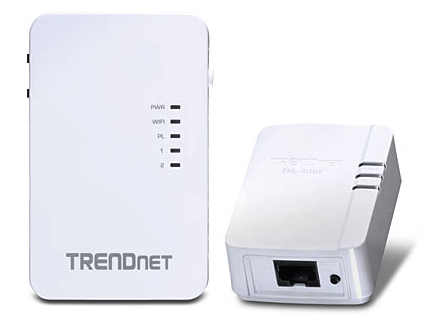TRENDnet Ships Powerline 500 Wireless Kit
Here's another way to extend your wireless network.
TRENDnet said on that it has shipped the Powerline 500 AV Wireless Kit, model TPL-410APK. This starter kit allows users to extend a network using existing electrical lines in the home or office. This starter kit sells for $124.99, and includes the Powerline 500 AV Nano adapter and the Powerline 500 AV Wireless Access Point.
"The TPL-410APK is well suited to extend a wireless network in large homes or homes built with concrete or masonry construction which degrades wireless signals," stated Zak Wood, director of global marketing for TRENDnet. "Installation couldn't be easier. Simply plug in the adapters and you're up and running."
The idea behind this bundle is to extend your home or office wireless network into areas the router can't reach. Thanks to an Ethernet port, users can plug the AV Nano adapter into an electrical outlet on a wall, and connect the Ethernet port to one of the router's four wired ports.
The Wireless Access Point is then plugged into another electrical outlet 5000 square feet away (980 ft. linear distance over electrical power lines), which will automatically connect to the Nano adapter. There are two Ethernet ports on this model too in case you have a device that doesn't do wireless (desktop, console, Smart TV, etc.). The wireless aspect provides speeds up to 300 Mbps on the 2.4 GHz band (Wireless N). Need an extra Powerline 500 AV Wireless Access Point? These can be purchased for $72.99 each.
If the Powerline 500 AV series is too expensive, the company also provides the Powerline 500 AV2 series, with a kit of two (TPL-408E2K) costing $92.99. The difference, it seems, is that this bundle includes two TPL-408E adapters; there's no nano-sized adapter, there's only one Ethernet port on each device, and there's no wireless connectivity.
For more information about TRENDnet's Powerline 500 networking solutions, head here.
Get Tom's Hardware's best news and in-depth reviews, straight to your inbox.

Kevin Parrish has over a decade of experience as a writer, editor, and product tester. His work focused on computer hardware, networking equipment, smartphones, tablets, gaming consoles, and other internet-connected devices. His work has appeared in Tom's Hardware, Tom's Guide, Maximum PC, Digital Trends, Android Authority, How-To Geek, Lifewire, and others.
-
Haravikk Kind of a mixed message on usage here; the whole benefit to me of PowerLine networking is being able to use reliable, wired networking rather than being at the mercy of range and interference of wireless. While I do keep a wireless network for smart phones etc., all my computers are now hooked into PowerLine adaptors, as it's just so much less frustrating to use than WiFi. I understand using WiFi for devices without a fixed location, but seriously; if your computer doesn't move, then it doesn't need WiFi, and you'll be happier without it.Reply -
Haravikk Kind of a mixed message on usage here; the whole benefit to me of PowerLine networking is being able to use reliable, wired networking rather than being at the mercy of range and interference of wireless. While I do keep a wireless network for smart phones etc., all my computers are now hooked into PowerLine adaptors, as it's just so much less frustrating to use than WiFi. I understand using WiFi for devices without a fixed location, but seriously; if your computer doesn't move, then it doesn't need WiFi, and you'll be happier without it.Reply -
WithoutWeakness ReplyKind of a mixed message on usage here; the whole benefit to me of PowerLine networking is being able to use reliable, wired networking rather than being at the mercy of range and interference of wireless. While I do keep a wireless network for smart phones etc., all my computers are now hooked into PowerLine adaptors, as it's just so much less frustrating to use than WiFi. I understand using WiFi for devices without a fixed location, but seriously; if your computer doesn't move, then it doesn't need WiFi, and you'll be happier without it.
At my house I have my modem and router hooked up next to my desktop in my office so that I can have my desktop wired directly into the router. However, my office is on the second floor in the corner of my house, hardly the best spot to ensure proper wireless coverage of my whole house. I currently have a 4-port powerline kit connecting my router in my office to my Roku in my basement so that I have a solid connection there but I also have a wireless access point running off of the powerline kit in the basement to allow for a stronger connectiion for that floor.With a kit like this I wouldn't need that second access point downstairs; it would just be built into the powerline kit,
I actually have a TrendNet kit already so I may snag one of these if it operates on a compatible frequency.
